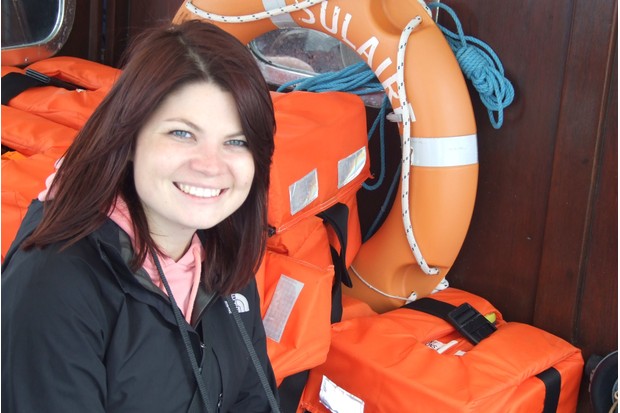An extraordinary fossil found in the UK is revealing the secrets of a predator that lived 150 million years ago
Sea monsters are associated with myth and legend, but there were definitely terrifying animals that once swam in our oceans. Following the recent unearthing of an enormous skull in the south of England, science is uncovering the tale of a powerful marine reptile.
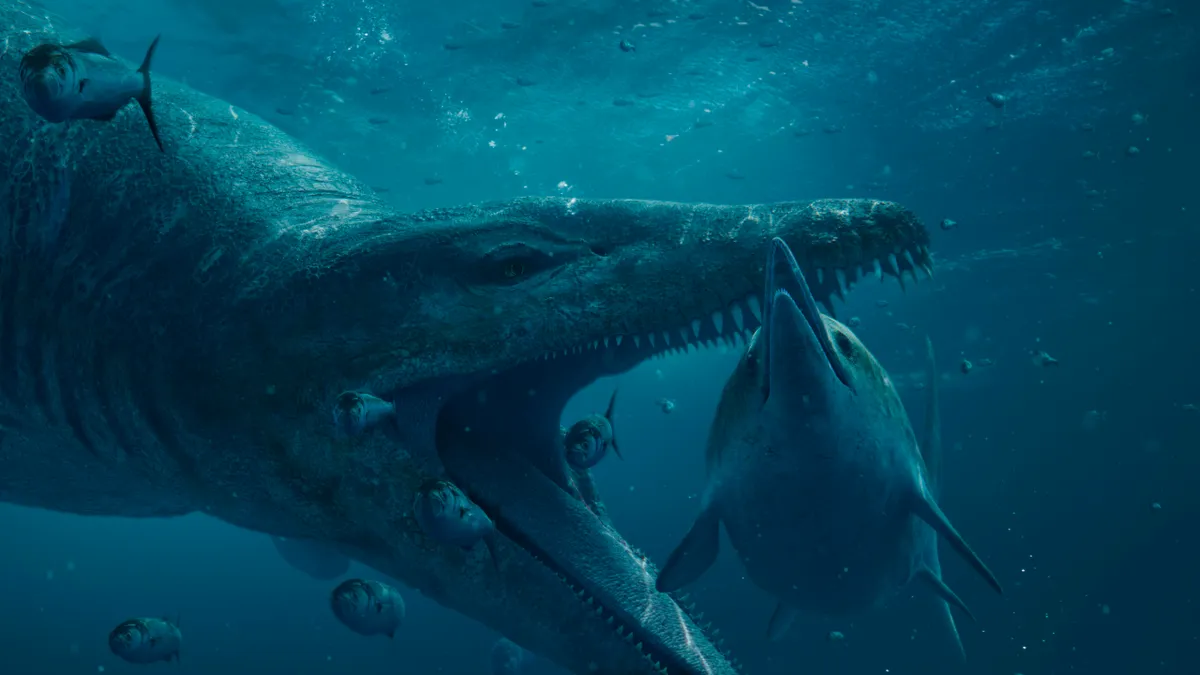
The exceptionally rare find is the focus of a BBC One documentary, presented by Sir David Attenborough, and is captivating palaeontologists as they reveal new and thrilling information about a ferocious ‘sea rex’.
The 150-million-year-old fossil belongs to a pliosaur, believed to be the biggest and most fearsome hunter that ruled prehistoric waters off the coast of Britain. “The creature would have been horrendously scary,” says executive producer Mike Gunton. “It’s like joining a great white [shark], a saltwater crocodile and a killer whale together with a little bit of penguin.”
Before filming commenced, Mike visited David Attenborough to talk about the pliosaur specimen and plans for the programme. “He was fascinated and asked, ‘Can I be in it?’,” recalls Mike. “It was all decided over a cup of tea in his study. We knew it would be an amazing story, but there was a lot of time pressure as the skull needed to be excavated quickly in case it fell away [from the cliff].”
The following week, David was on location to film the opening shot of this compelling detective story. Throughout the show, he joins experts to analyse the fossil and unlock clues to the appearance and behaviour of the colossal creature to which it once belonged.
The snout of the pliosaur skull was discovered lying in shingle by fossil enthusiast Phil Jacobs while he was walking along a beach near Kimmeridge Bay, Dorset. He alerted local and experienced palaeontologist Steve Etches, who identified the location of the rest of the skull by examining the fault lines in the cliff face using a drone.
As the prize was located 12m up the cliff, the only way to reach it was to abseil down from the top and conduct the whole dig on ropes. Steve assembled a team of experts, including fellow fossil hunter Chris Moore, to help excavate the skull by the end of summer 2022.
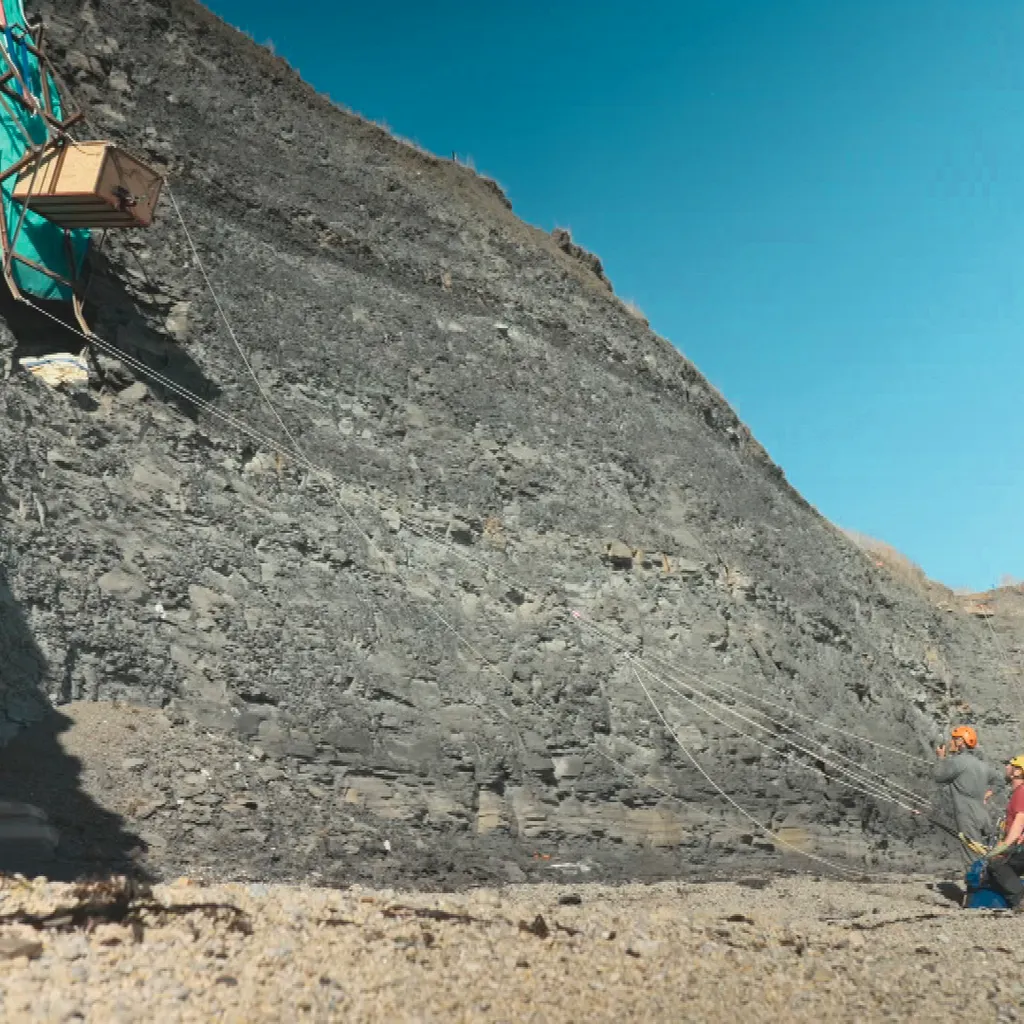
“It took three to four weeks to complete,” says producer-director Victoria Bobin, “and was by far the biggest filming challenge, as there are so many health and safety considerations.” Nets were used to stop any loose rock rolling down and hitting the excavators as they worked, and when the skull was released from the rock, a special crate was required to haul it to the top of the cliff on skids. The weather also proved tricky for Victoria and her colleagues when they tried to film sequences with David on a rocky boat. “While some of the crew were feeling a bit green, David was fine, telling me, ‘I was in the navy’,” she recalls.
In the documentary, the revered broadcaster takes viewers on a journey of discovery. “David comes at programmes like this in a different way,” says Mike. “He’s not telling you stuff, he’s exploring with you.”
Armed with razor-sharp fangs and at nearly 2m long, we learn that the 500kg fossil is virtually undamaged (most skulls are smashed before fossilisation) and therefore able to reveal all kinds of astounding details about these reptiles. “It’s rare that an animal just dies peacefully, falls to the bottom of the sea, and is perfectly preserved. Though it might have happened to this one,” says Mike.
“It is one of the largest and most intact pliosaur skulls ever found, resting with its mouth closed,” says executive producer Tom Jarvis. “It is like taking a snapshot of an animal while it is still alive in a way because all the joints, bones and teeth are in the right place, so that’s super useful for scientists,” adds Mike.
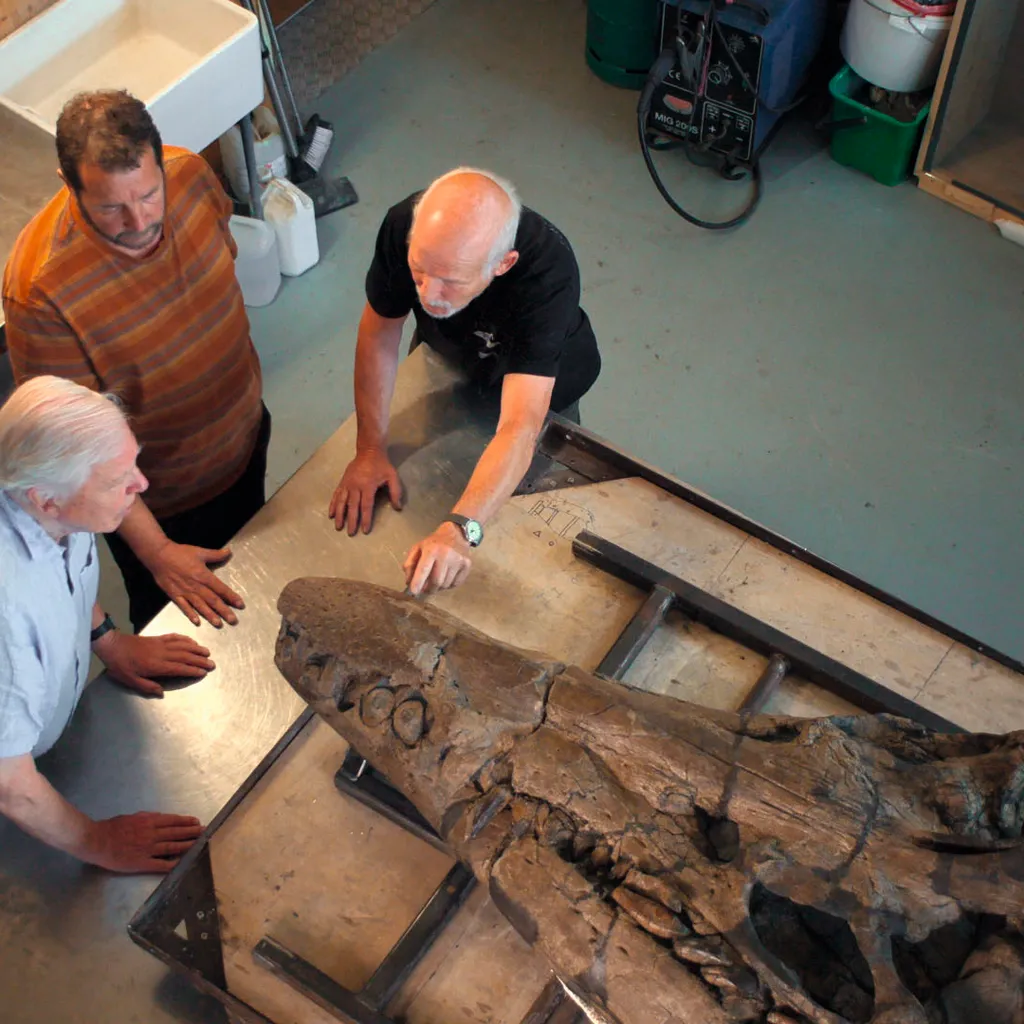
A CT scan, which took five days to complete because the skull was so dense, and a 3D surface scan conducted by paleobiologist Andre Rowe, tell us more about the senses and biomechanics of the animal.
“This is actually one in a million, maybe one in a billion-type specimen,” says Andre. “I have no doubt that this pliosaur was the T.rex of the seas.”
Dorset’s Jurassic Coast is renowned as one of the best places in the world for marine fossils as its cliffs were once seabeds.
Fast-moving ichthyosaurs and long-necked plesiosaurs (related to pliosaurs) – both famously discovered by palaeontologist Mary Anning in this area in the 1800s – are thought to be the prey of the pliosaur.

The sea monster has interlocking, almost triangular teeth, which each have two sharp cutting edges and a flat face on the inside. This has enabled experts to match the distinctive tooth holes on ichthyosaur and plesiosaur fossils with the bite of the pliosaur.
The back of each pliosaur tooth is also marked with fine ridges known as striations, which would have helped the up to 12m-long hunter (approximately the size of a double-decker bus) to pierce the flesh of its victims while preventing a vacuum from forming. This animal would have been able to quickly extract its teeth for a second brutal attack and a swift, successful kill.

It wasn’t just large marine species that were on the menu for this gigantic creature. The pliosaur’s triangular, streamlined skull contained long, sharp teeth at the front of its jaws and more hook-like teeth at the back. This meant it could feed in a variety of ways, from grabbing large prey to gripping smaller, slippery fish. Once it had a meal in its grasp, as many as 130 teeth and powerful pterygoid muscles could deliver a devastating bite.
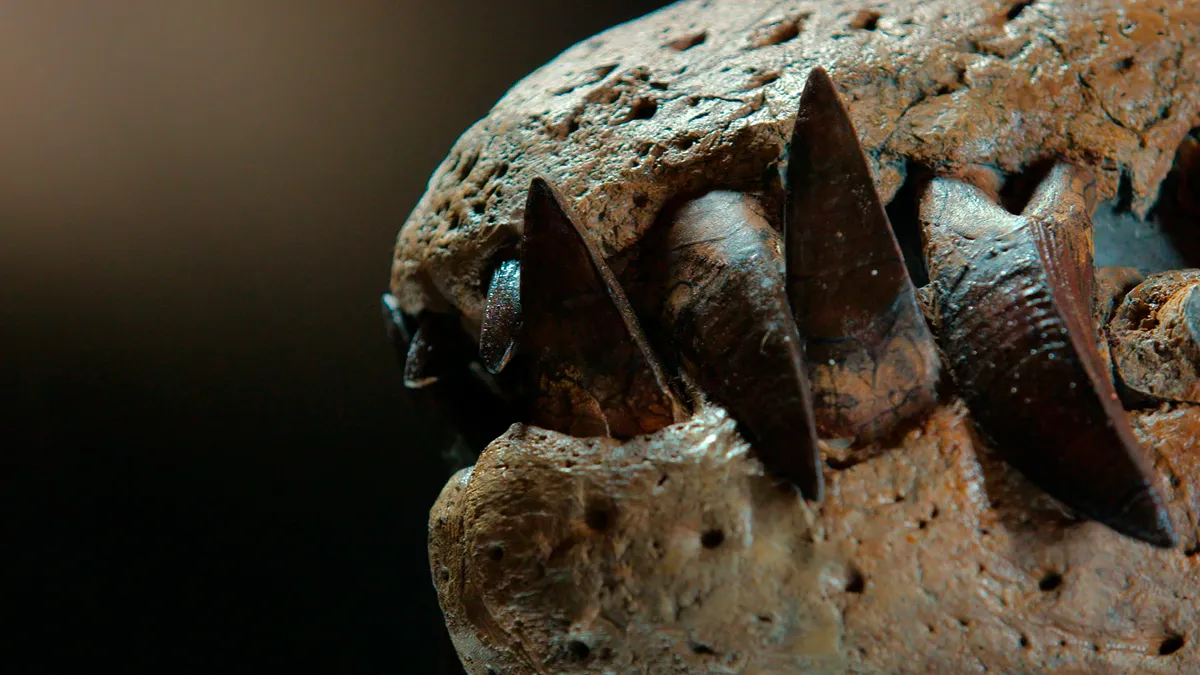
Saltwater crocodiles have the largest bite force of any living animal at up to 16,000 newtons. In comparison, the pliosaur’s bite force (calculated from the size of its muscles) has been estimated at 32,000 newtons by Emily Rayfield. “I’m pretty sure it could bite through a car,” she tells David. Combined with its ability to accelerate up to approximately 30mph, this was also one of the fastest animals in Jurassic seas and certainly an apex predator in its ecosystems.
From other pliosaur fossils that have been found, it has been documented that the animals have tear-shaped bodies and short necks. The marine reptile would have had four almost-identical, wing-like flippers, each 2m long, which acted like propellers, driving it through the water.
Science suggests that the sea monster swam in a way that is similar to penguins, using an underwater flight movement. The hind flippers of the pliosaur could operate at a much higher thrust and efficiency as they used the wake of the flippers in front, allowing the animal to increase its swimming speed and therefore the variety of species it could eat. If this wasn’t enough to make an ichthyosaur flee, the sea monster was able to detect changes in pressure, such as the turbulence created by swimming prey, using sensory pits on its snout.
There are also indications that the eyes were important for this marine predator, according to palaeontologist Judyth Sassoon. One of the reasons for this is their position: they are located on either side of the head, approximately in the middle. This could have allowed the pliosaur to pursue prey accurately and attack it from below.
Another intriguing feature identified in Attenborough and the Giant Sea Monster is the existence of a photoreceptive parietal eye, also known as a third eye. Some species today still have this feature (bearded dragons, for example) and it is thought to help regulate circadian rhythms. The function of the pliosaur’s parietal eye is unclear but it could have helped it to orientate itself while swimming at depth.
“There isn’t a huge amount known about the pliosaur, which is why this find is hugely significant,” says Victoria. “There are currently eight recognised pliosaur species and this could be the ninth.” Judyth has taken measurements of this specimen and the proportions seem to differ from the other pliosaurs – the position of its eyes, nose and crest suggest something new.
After a collaborative scientific effort and painstaking restoration, the rare fossil is now on display at The Etches Collection Museum of Jurassic Marine Life in Kimmeridge, Dorset, founded by Steve Etches in 2016. “It is one of, if not the most important specimen ever to come out of the Kimmeridge clay, and globally, this is one of the best specimens you’ll see,” he says.
Though the find has been able to provide a huge amount of data on this species, there is still more research to be done and possibly more preserved remains to recover. “Steve feels very strongly that the whole pliosaur is in the cliff, and he is keen to get it out in the future,” says Victoria.
Unlike the more familiar BBC natural history series that observe and record wildlife, this documentary has been all about reconstructing an animal’s behaviour from clues. “Our journey of discovery has shown that this sea monster was one of the greatest predators the world has ever seen,” concludes David.
“The show has galvanised the scientific community, which is one of the joys of making a programme like this,” says Tom. “If Attenborough wants to investigate something, it brings people together.”
How to raise a monster
The BBC film crew explains some of the processes behind resurrecting a hunting pliosaur
Attenborough and the Giant Sea Monster relies on cutting-edge visual effects to bring the pliosaur to life, highlighting its size, strength and how it may have hunted in Jurassic seas.
“CGI really comes into play in the programme,” says Victoria. “We created the creature based on the scientific information we have.” The biomechanics of the animal are deduced from analysis of skeletal joints, muscle attachments and comparative anatomy (looking at the similarities in the anatomical structure of different species, including animals that are alive today).
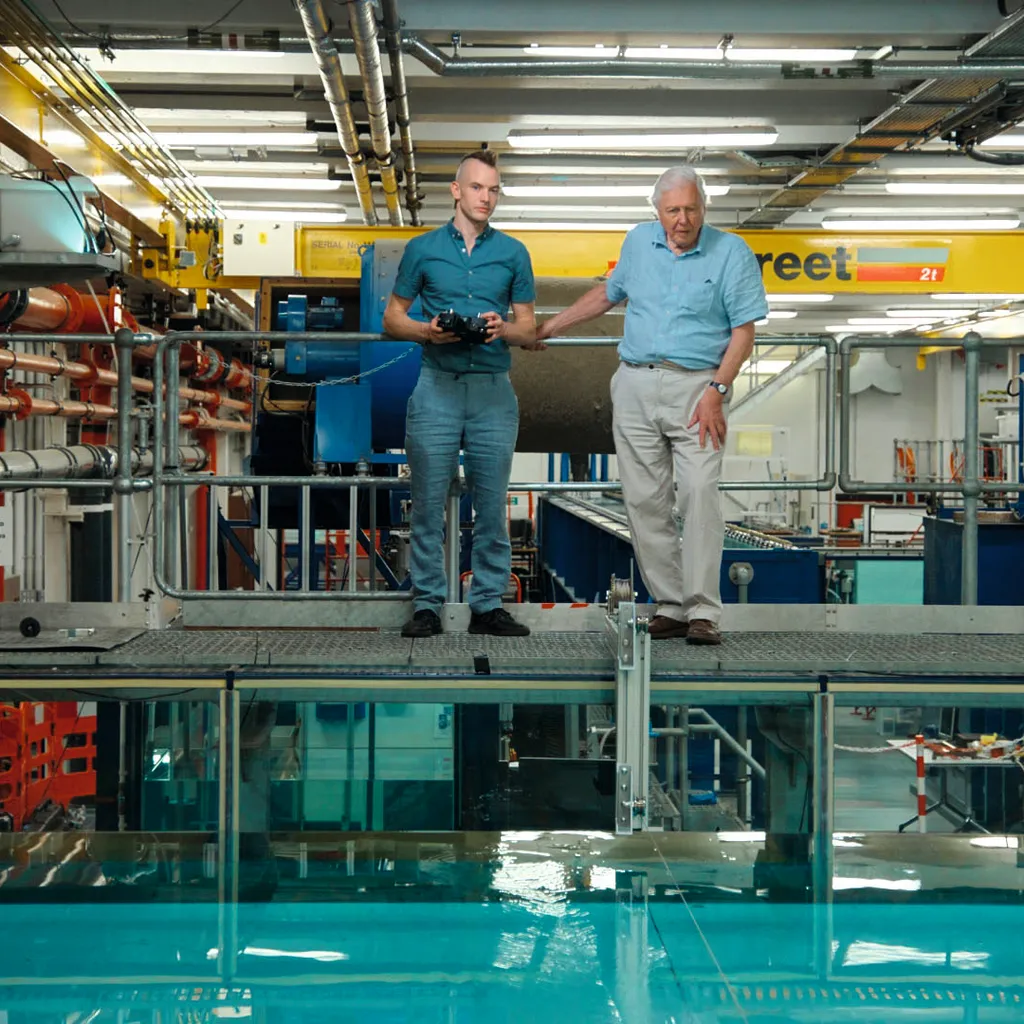
From this data, a computer model can be built of the basic skeleton and musculature. By inputting parameters that can be adjusted, an initial swim cycle is created and revised until the pliosaur starts to behave like a real animal.
“Human intuition is an important part of getting it right,” says Mike. The whole process is a combination of technology, science and art: “250 texture layers and 8,000 hours of render time were required to build the pliosaur’s skin – that’s about a whole year,” says Tom.
As the muscles and joints are added to the computer model, the options for the skeleton to move become fewer as there are limitations to each addition. “That’s what’s fascinating for the scientists because they often don’t have the machinery or the resources to do that,” says Mike. “When we do that for them, they go ‘Oh my gosh, that’s how it does that,’ or ‘I thought it did that’. It’s a lovely moment.”
How do I watch the documentary?
Enjoy the entire documentary, Attenborough and the Giant Sea Monster, on BBC iPlayer
Want to find out more?
We caught up with Sir David Attenborough to hear more about his documentary, Attenborough and the Giant Sea Monster.
Check out our comprehensive fossil guide and our experts answer top dinosaur questions, including how were dinosaur footprints preserved? and can a dinosaur be mummified?
